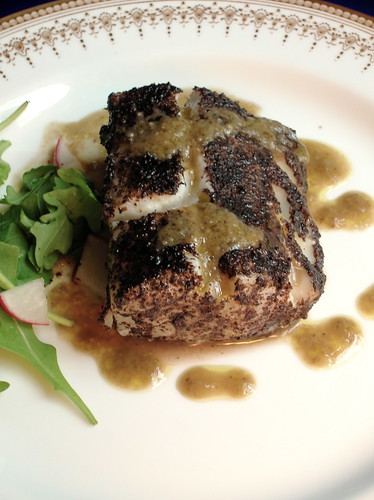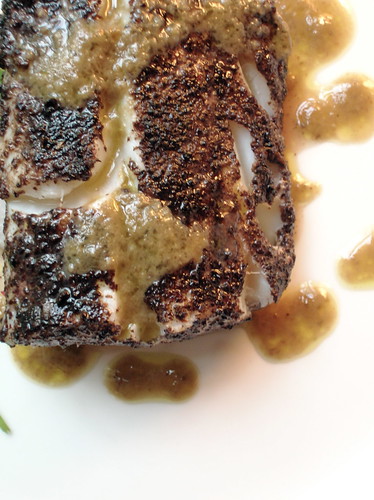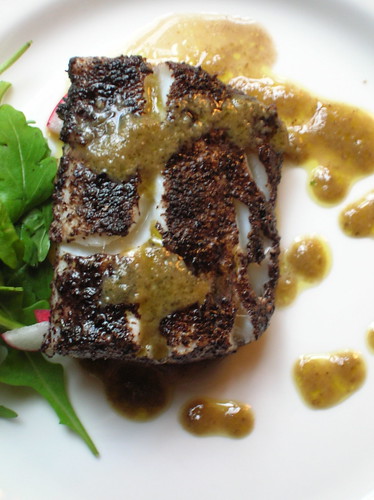

Let's cut straight to the chase today: this dish was delicious. The only sad part was the next day, when we realized there wasn't any more of it left, at which point I just went and put it together again. Luckily, it comes together in mere minutes, so we kept the hungry-grumpy me at bay (and that is always a good thing).
It all started with a little recipe for 'black olive oil' I spied in Samuelsson's The Soul of a New Cuisine. With such an evocative name, I had visions of a dark-as-night sauce, thick and rich as an oil well. Obviously, I didn't think that one through, because the name comes from the fact that the oil is made with black olives, not that it is really black-colored. As I soon realized, black olives are sort of grey on the inside, so there I was with a big batch of tasty but slightly grey-green sauce. All dressed up and nowhere to go.
I had picked up some cod fillets, and when I saw the little sack of sumac on my counter, inspiration struck. Why not roll the cod in the sumac, then serve it with the olive oil? I had no idea if it would work, since I'd never heard of such a dish. As we sat down to dinner I waited nervously as the first mouthfuls were chewed; there was a pause, and then a murmur of approval. And it was good, as I dug in my own fork. Sumac, made from dried berries, has a very mild taste, so it doesn't overpower the fish, but just adds a tart compliment to it. It is available in the spice section of most groceries and in Middle Eastern markets, and don't worry, it shares no relation with the North American poison sumac. Any leftover black-olive oil can be used for dipping bread and rubbing on meats and even as a salad dressing. All in all, a dish worth repeating.

Sumac Crusted Cod with Black Olive Sauce
The tart but mild sumac is a perfect foil for meaty fish such as cod.
2 lb cod fillets
1/4 cup sumac
black olive oil, recipe follows
2 tbl olive oil
1. Cut the cod fillets into serving-sized pieces, rub about 1/2 cup of the black olive oil all over the fillets and set aside to marinate for half an hour, or up to two hours.
2. Preheat the oven to 400 F. Wipe off any excess marinade from the fish. Roll each piece of cod in the sumac to coat. Heat the olive oil in a wide skillet over medium heat. Add the cod fillets to the skillet and cook for about 3 minutes on each side, using tongs to gently turn the fish. Once the cod is sauteed on both sides, remove from the skillet, and transfer to a baking sheet. Place the cod in the oven for another five minutes to finish cooking, the fish should be plump, opaque, and just begining to flake easily. Depending on how thick your fillets are, you may not need to use the oven at all, or you may want a longer time in the oven. Serve immediately, with black olive oil drizzled on top.
Black Olive Oil
This gets it's name from the fact that it is made with black olives, not from it's color. It's a delicious sauce with flavors evocative of tapenade and has a myriad of uses, from marinating fish, drizzling on bread, or tossing with salad. Adapted from Marcus Samuelsson.
1/3 cup black olives, pitted
1 anchovy, or 1 tsp anchovy paste
1 cup extra virgin olive oil
1 garlic clove
1 thyme sprig, leaves only, chopped
1 tbl lemon juice
Combine all ingredients in a blender, puree until smooth.
__

Very cool combo. Where does one find edible sumac? My only sumac experience is with poison sumac (not good.....) so the idea of it as an edible is entirely new to me.
ReplyDeleteDo share..... :)
I love this dish, Mercedes. Love it. It looks incredible. The olive sauce won my heart. :)
ReplyDeleteVery nice recipe!
ReplyDeleteI love sumac and it has such a great affinity with mild meat like cod (which is technically fish but you know what I mean) and chicken. I love fish with that deep spicy crust!
ReplyDeleteHa! I meant to add a note about the sumac in the post. This sumac is a Midde Eastern berry, no relation to the poisonous sumac found in North America. It's available in the spice rack at most groceries, and at Middle Eastern stores.
ReplyDeleteOh boy now I have a use for sumac! This looks and sounds terrific.
ReplyDelete